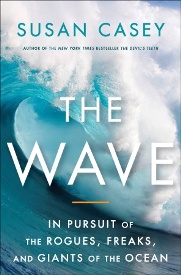
The Wave: In Pursuit of the Rogues, Freak and Giants of the Ocean
by Susan Casey
–Reviewed by Dianna Delling
 Forty-foot waves that most surfers can only dream of riding? Those just don’t do it for Laird Hamilton. The California-born, Hawaii-bred athlete craves bigger challenges, the kind of swells that send oil rig workers packing and can break a container ship in two. Hamilton is one of the few people on earth who’ve seen (and lived to talk about) a hundred-foot wave. He’s one of an even small group of people who have actually surfed one.
Forty-foot waves that most surfers can only dream of riding? Those just don’t do it for Laird Hamilton. The California-born, Hawaii-bred athlete craves bigger challenges, the kind of swells that send oil rig workers packing and can break a container ship in two. Hamilton is one of the few people on earth who’ve seen (and lived to talk about) a hundred-foot wave. He’s one of an even small group of people who have actually surfed one.
In The Wave, journalist (and O, The Oprah Magazine editor) Susan Casey immerses herself in the world of extreme, or big-wave, surfing, following Hamilton and his peers around the world as they go head to head with the monsters of the sea. In surf lingo, “big-wave surfing” involves waves higher than about 20 feet. But these athletes regularly tackle waves 50 feet and higher, which move so fast that paddling into them is impossible. Instead, the surfers use Jet Skis and rope to tow each other into the fray. “The members of this rarefied tribe – maybe only fifty highly skilled riders across the globe – don’t just stumble across giant waves or steer their ships clear of them or consider them as equations on a computer screen, they seek them out,” Casey writes. Just what drives them, and what’s causing the increasingly common skyscraper-size waves to form in the first place, are questions she’s out to answer in this fast-paced narrative that brings to mind adventure blockbusters like The Perfect Storm.
She hangs with Hamilton and his wife, beach volleyball player Gabby Reece, at their home in Hawaii; she accompanies wave-rabid surfers as they hop planes – at a moment’s notice, after last-minute predictions by storm forecasters – to remote beaches in Mexico, Tahiti, and California. An accomplished competitive swimmer who’s comfortable in big water, she even follows her subjects out into the surf. That’s impressive when you consider the power of the waves in question. When one holds you down, surfer Brett Lickle tells her, it’s like “sprinting four hundred yards holding your breath while being beaten on by five Mike Tysons.”
Casey also meets up with academics, who explain what little is known at this point about the complex physics behind giant waves. Hundred-footers were thought of as scientific impossibilities – maritime legends akin to mermaids – as little as 20 years ago; thanks to satellites that now monitor the farthest reaches of the oceans, they are now considered “fairly common.” Just how common, and how and when they are likely to form, has yet to be determined. Will the rising ocean temperatures associated with global warming mean we’ll see more freak waves in years ahead? The jury’s still out on that too.
While she never mounts a board, Casey does ride a Jet-Ski, steered by Hamilton, over a 40-foot stunner at the California break known as Jaws. “The G-forces made it hard to turn my head, but at the edges of my vision I saw spray and froth and the blood beat hard in my ears as the wave bellowed only yards behind us,” she writes of the experience. “Though it would be weeks before I fully processed the feeling of riding Jaws, nothing I had ever done or seen or been through had made me feel so alive.”
Casey’s high-adrenaline prose, and her willingness to dive right in with her subjects, makes The Wave one of the best, most accessible books on surfing – and the phenomenon of big waves in general – out there.
Buy the Book: Skylight, Powell’s, Amazon, Borders
Further Reading: The Devil’s Teeth: A True Story of Obsession and Survival Among America’s Great White Sharks by Susan Casey and The Power of the Sea: Tsunamis, Storm Surges, Rogue Waves, and Our Quest to Predict Disasters
by Bruce Parker
*Photo courtesy Duncan Rawlinson’s Online Photography School.




Send A Letter To the Editors